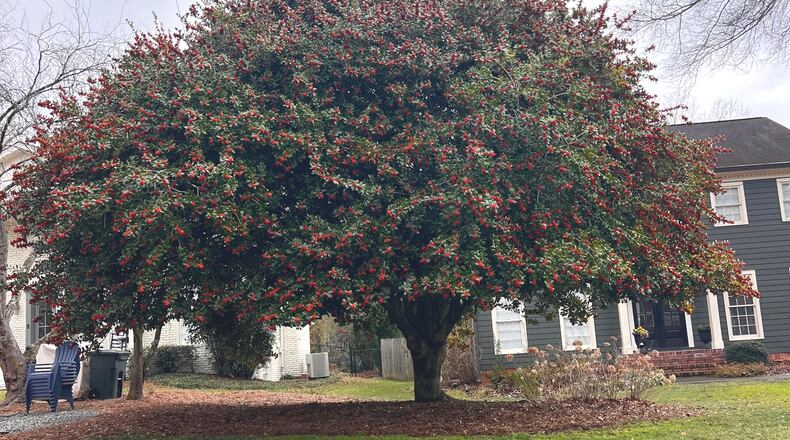Q: My neighbors and I have seen several beautiful trees around Atlanta that look like they are approximately 30 feet to 40 feet tall with berries, and we are curious if they make berries like this every year. I know the bushes do, but I am not sure about trees like this. — Justin Greear, email
A: I have been astounded this year to see the number of berries on most hollies, but particularly the Burford hollies, which can be pruned to tree form. This holly has the ability to produce berries without needing pollination. This is called parthenogenesis, and Burford hollies aren’t the only plant that can do this. Burford holly combines three characteristics that make it outstanding: fast growth, parthenogenesis and hardiness.
When the plant was discovered in Westview Cemetery in southwest Atlanta, it immediately stood out. Every Burford holly in the world came from here.
I don’t know what causes bountiful berry years for Burford as well as hollies that need pollination, but I have some guesses. If there’s a hard rain when the flowers are open, it harms the pollen and pollen receptors in holly flowers. Warm weather is a must because cold-blooded insects slow down when it’s cool. The summer should be mild with no extreme dry periods. Given a good growing environment, hollies can amaze viewers driving past at 60 mph.
Q: My grass lawn is becoming a moss lawn of its own accord. What can I do to help it become a moss lawn? Eliminate weeds and sparse grass? — Karen Daugherty, Roswell
A: Grass to moss is the direction of a lot of lawns. As trees grow larger, their shadow encroaches on what were formerly sunny lawns.
Aristotle observed, “Nature abhors a vacuum.” Your thinning lawn is a vacuum that attracts plants that enjoy a shady environment. My colleague, Theresa Schrum, noted that “Nature always bats last.” You have wisely chosen to go in the direction nature wants to go anyway. Moss is not hard to grow as long as it’s moist continuously, even in summer.
I would buy two or three lawn sprinklers and put them in the largest areas of your lawn and turn them on. The moisture footprint of the sprinklers tells you where to concentrate your moss lawn. It could be square, full circle or a half-circle — whatever your sprinkler’s pattern is. Connect them all to a hose manifold and connect the manifold to your faucet.
Now all you have to do is turn on that one faucet to water your entire moss lawn multiple times a day when it’s hot. I have found that a very, very light spritz of glyphosate will kill weeds and grasses without much harm to the moss.
About the Author
Keep Reading
The Latest
Featured


